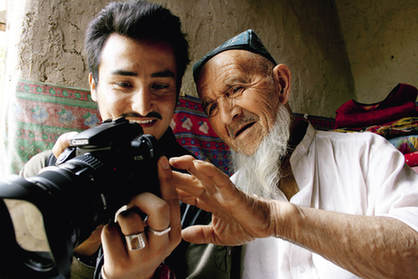Kurbanjan Samat: The Photographer
Kurbanjan Samat couldn’t sleep on the night of March 1, 2014, after hearing news that 29 people had been killed by eight Uygur assailants at Kunming Railway Station in Yunnan Province. Authorities identified the assailants as part of separatist forces from Xinjiang Uygur Autonomous Region. Kurbanjan felt enraged and upset when he saw Weibo bloggers carelessly blaming everyone from Xinjiang. He decided to retort to biases with a photo series titled I’m from Xinjiang.
 |
|
Kurbanjan with a mulberry paper maker in 2007. |
Every photo is a portrait snapped since late 2013, focusing on Xinjiang natives working in other parts of the country, even overseas. “Our people have been alienated, labeled violent and terrorists,” he frowned. “I wanted my pictures to show true faces.”
Kurbanjan has experienced many headaches due to his Xinjiang heritage. Soon after the Kunming Incident, he and his friends were searched by police in Beijing. He received phone calls from the local police station asking how long he was planning to stay in Beijing. “I’m going to stay here forever!” he couldn’t help but rage. “Send me to Babaoshan [a local cemetery] when I die!”
Born in Hotan, Xinjiang, in 1982, Kurbanjan has lived in Beijing for eight years. He bought his first camera at 17. His work experience is quite diverse: boxer, barbecue operator, and jade salesman, through which he met directors Meng Xiaocheng and Li Xiaodong from CCTV, China’s biggest media outlet, who got him involved in shooting documentaries. In 2006, he came to Beijing to study at Communication University of China. He has been a camera operator for CCTV ever since.
After living and working in Beijing for so long, Kurbanjan has seldom felt uncomfortable because of his ethnicity. In college, he got along well with everyone, and was known as “Brother Jan.” His organizational skills are exceptional, and his performance at work is frequently lauded. His female colleagues affectionately nicknamed him “Banban.” The director seldom calls him by name but refers to him as “Little Kur,” appreciating his maturity, good looks, positive attitude and honesty. Nobody has a problem with him being a Uygur from Xinjiang.
Bigotry derives from ignorance about Xinjiang people. “Xinjiang is inhabited by 13 ethnic groups, none of which can represent the entire population,” Kurbanjan said. The faces in his pictures showcase 11 local peoples, including Uygur, Han, and Mongolian, among others. When completed, his photo series will comprehensively cover the diversity of people from all of the region’s 13 ethnic groups and across ages and professions ranging from street peddlers to corporate executives. Common ground will hardly be found other than that they all hail from Xinjiang.
“One reason to stay in Beijing is to serve as a bridge between the capital and Xinjiang,” Kurbanjan said. “I want to interpret my people with photos.” Life in Beijing hasn’t been easy, however. Kicked out by his original host family, he had no place to go but a basement for RMB 7 a night. He worked at a television station for a humble salary. After months of struggles, he finally collapsed. For an entire year, he did nothing but stay inside, sleeping and playing online poker. Eventually, he found comfort by telling himself, “Things will be better next month.”
His great dream of bridging cultures was not the only thing helping him endure the bitterness of life in Beijing. He was lucky enough to find an opportunity that would fully utilize his talent. “He could make a fortune in jade,” a friend remarked, “but he made a different choice: He’s a TV guy.” He knew what he wanted. “Making documentaries has been a long-term dream, whatever it takes.”
